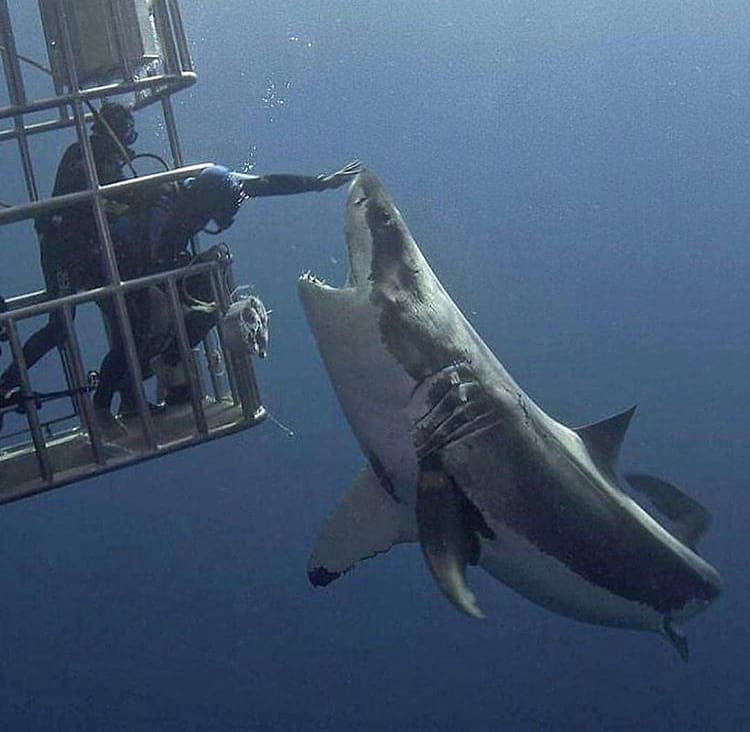Achieving Hollywood fame in movies like ‘Jaws’ and ‘The Meg’ the great white is one of the most widely known shark species.
They are also the species responsible for the highest number of shark attacks on humans every year, with a high percentage of these being fatal.
What is the Great White Shark?
The great white shark is the world’s largest predatory fish, and one of the most feared creatures in the world. They are the ocean’s apex predator, and one of the most aggressive shark species.
Most prominent in cool seas off South Africa, Australia and the USA, the white shark is a member of the Lamnidae family and the Genus Carcharodon.
Great White Shark vs White Shark
The names ‘Great White Shark’ and ‘White Shark’ both refer to the same species.
Scientists generally prefer to use the term White Shark due to the fact that there is no ‘lesser’ or ‘greater’ subspecies variants. However the name has stuck nonetheless and they are most commonly referred to as the Great White Shark or simply Great White.
Appearance
What does the Great White Shark look like?
Great whites have large, torpedo shaped bodies with giant mouths, pointed heads and iconic shark fins. These are two pectoral fins and a triangular dorsal fin.
White sharks are slate in colour and covered in tiny, tooth-like scales known as ‘dermal denticles. These protect the skin from damage and are constantly replaced. These are incredibly rough to the tough, and can remove skin off a human hand if rubbed the wrong way.
They have a two-tone colouration, dark grey on top and pearl white on the bottom – this is where their name comes from.
Like with other shark species, this is a hunting adaptation which helps them to remain camouflaged from above and below.
When approaching a prey item from below, they will blend in the depth of the ocean floor, or when swimming above they will appear light, similar to the sun’s rays shining in through the surface of the water.
How big is the Great White Shark?
Great white sharks are huge! Adults average between 16 and 18 feet (5-6 meters) but large individuals can grow to well over 20 foot long (7m+). Females are the larger of the two genders and are generally the dominant sex.
Mature great whites weigh between 4,000 and 7,000 pounds (1,800-3175kg) on average.
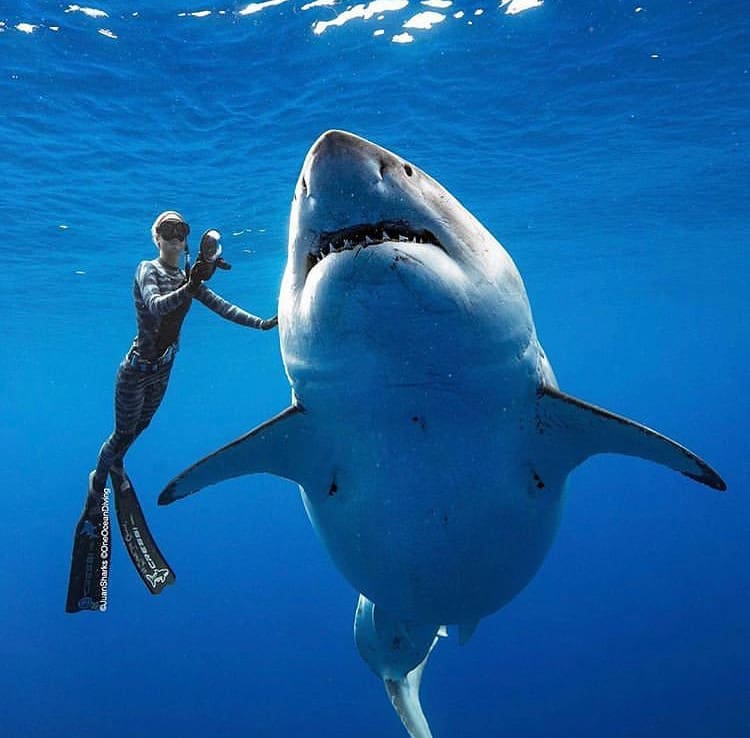
How many teeth do Great White Sharks have?
Great white sharks have more than 300 razor sharp, serrated teeth. These are arranged in rows and are expertly designed for grabbing and tearing through flesh. Each tooth measure about 3 inches (7.5 centimetres) in length.
Sharks are one of the only species who are able to constantly replace teeth throughout their lives. Replacement sets are pre-grown within their jaws, and are ready to move forwards as soon as any of the current set fall out.
It is thought that great whites can go through more than 20,000 teeth during their lives.
Great White Shark gills
The great white shark has 5 gill slits on either side, which sit in between the mouth and pectoral fins. Gills are how the great white shark is able to extract oxygen from the water.
The breathing process happens as water is taken in through the sharks mouth and pressed back out through their gills. As water passes through the gills, an intricate network of capillaries absorbs the oxygen and transports it directly into the bloodstream.
This technique is only possible with constant movement and an open mouth, which is why the great white shark never stops swimming, even when resting.
Behaviour
What do Great White Sharks eat?
The great white shark is a carnivore that hunts or scavenges for its food.
Food sources vary slightly according to geographic location, however the most common prey item are seals. They are also known to feed on dolphins, bony fish and sea lions, and will always scavenge off the carcasses of whales and other large mammals.
They also readily feed on small-toothed whales, tuna, rays and skates.
How do Great White Sharks hunt?
Great white sharks have very well developed senses in order to seek out prey in the vast oceans. They have strong smell, sight and hearing and leverage all of these when searching for prey. It is thought they can smell a single drop of blood in 5 million litres of water.
These predators hunt through a few different methods. The first and most common involves a slow, steady approach from below. The shark will ease in until its just a few feet away and then proceed to attack with speed. They will move to the surface, bite down and shake their head.
The second and most eerie of the great white shark’s hunting methods is also its most iconic. The surface charge method sees the shark circling patiently in the depths after having spotted a potential prey item at the surface.
When the time is right, the shark will begin to swim towards the surface with an incredible speed, before hitting their victim with an immense amount of force. On some occasions they will simultaneously grab the prey item in their jaws, on others they will simply knock and stun them. In both instances, the shark and its prey will fly out the water and great whites have often been seen fully breached.
Despite their lethal arsenal of teeth, great white sharks don’t actually chew their prey. Instead they use their teeth to tear their prey into large pieces, which are then swallowed whole.
How fast do Great White Sharks swim?
Despite their massive size, great white sharks can swim incredibly quickly when they need to. Generally they will maintain a steady pace when cruising through the shallows, but when hunting they can reach speeds of up to 15 miles per hour (24 kilometres per hour).
Do Great Whites migrate?
Great white sharks migrate thousands of miles on an annual cycle. Populations follow differing migration patterns depending on where they live, but these always fall in line with the movements of their prey items.
A great white’s migratory route can see the sharks travel more than 2,500 miles (4,000km) through the barren, open ocean before reaching their intended destination. Scientific study has discovered that the sharks are able to go long periods of time without food by fuelling themselves with the large fat reserves stored in their reserves.
 Social structure
Social structure
Very little is known about the great white shark social structure. Due to the vastness of the ocean and the migratory habits of the species, they are very hard to study.
Great white sharks are a largely solitary species, but there have been occasions were a pair of sharks have been seen swimming, hunting or feeding together.
Dominance is determined by age and size, and with females being the larger of the two genders – they are usually more dominant. Fights are rare but do occur and can result in horrific scarring and injury.
Habitat & Range
Where do great white sharks live?
Great white sharks can be found throughout all the world’s oceans. They prefer cool waters and tend to stick close to the coast. They will usually only venture out into the depths when migrating. White sharks are warm blooded and will mostly avoid tropical waters as the temperature may cause them to overheat.
The greatest concentrations of great white sharks are found in; USA, Mexico, South Africa, Japan, Australia, Chile and parts of the Mediterranean sea, but they are present in more than 100 countries across the world.
 Conservation
Conservation
How many great white sharks are there in the wild?
At present there are around 3,500 great white sharks living in our oceans. There are none living in captivity despite many attempts by scientists.
Are great white sharks endangered?
The great white shark is currently listed as ‘Vulnerable’ on the IUCN red list, and the population is at risk of becoming endangered.
Threats to the great white shark
As the apex predator in the ocean, white sharks have no real threat of predation. Only in very isolated incidents where orca’s have been recorded killing great whites and feeding on their liver.
The greatest threat to great white shark populations is fishing. Although they are protected from targeted fishing, they often fall victim to bycatch of fishing trawlers and shark-fin fisheries.
Safari
Where to dive with great white sharks?
Shark-cage diving is one of the most popular wildlife interactions in the world at the moment. The thrill of getting up close to these ancient oceanic predators that many tourists around the world look forward to every year.
Various tour companies operate diving operations in all great white ‘hotspots’.
The best places to dive with great white sharks are:
- Gaansbaai, South Africa
- Isla Guadalupe, Mexico
- Tiger Beach, Bahamas
- Oahu, Hawaii
- Farallo Islands, California
- Neptune Islands, Australia
Facts about the great white shark
- Scientific Name – Carcharodon carcharias
- Great whites are one of the most important species in the ocean – Along with all other shark species, great whites are arguably the most important fish in the sea. This is because they act as a means of population control, killing off weak and diseased creatures, ensuring the health of the ecosystem going forward.
- Bite force – the second strongest in the world at 4,000 pounds per square inch
Myths about the great white shark
- Great white sharks are ‘man-eating monsters’ – Great white sharks do not seek out humans as a source of food, and research suggests that they may even find human flesh unpalatable.
- Most great white shark attacks are fatal – The majority of white shark attacks are not fatal. Most of these are instances of ‘sample biting’. Once the shark has had a taste, they usually move off and ignore the victim. Unfortunately due to their size and strength, even a sample bite can be incredibly damaging to a human body.
- Culling and shark nets are an efficient way to prevent shark attacks – Studies have found no significance in using shark nets or culling as a means of preventing shark attacks. They have no impact whatsoever, but have a devastating impact on other species.



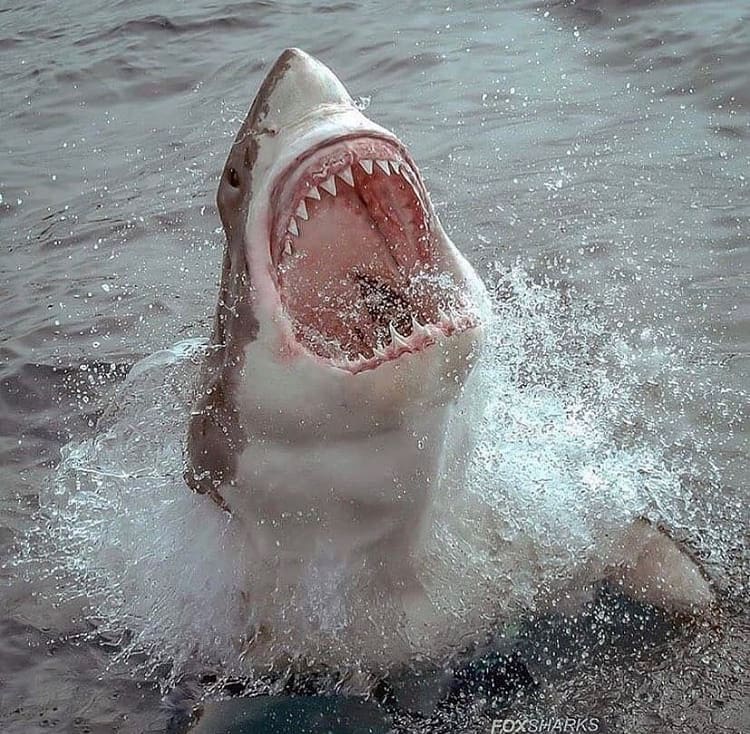

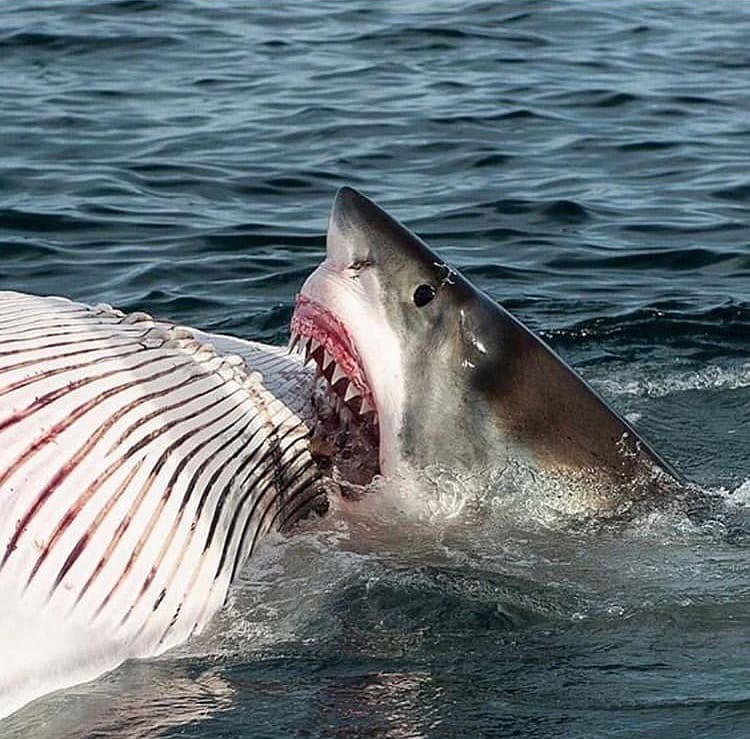

 Social structure
Social structure 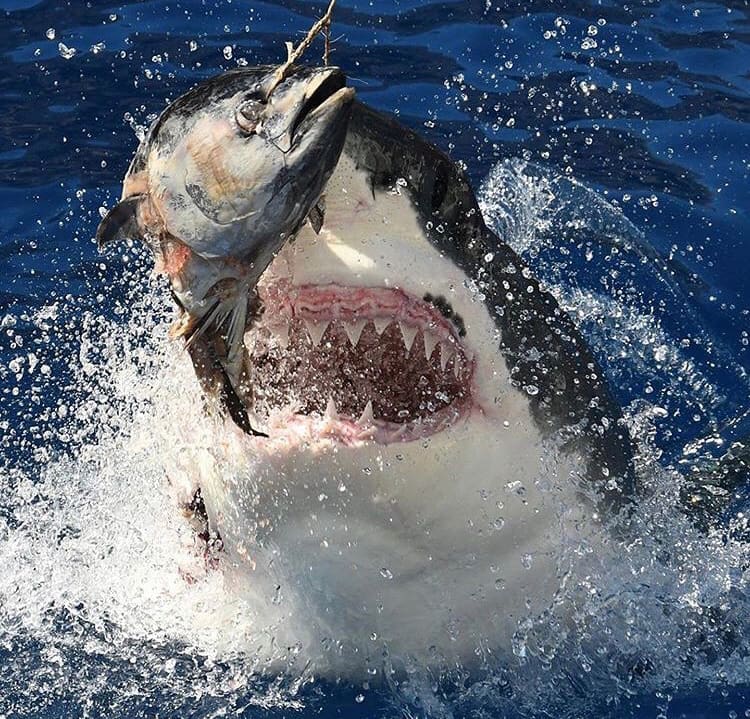 Conservation
Conservation